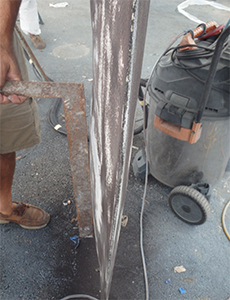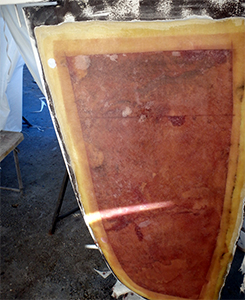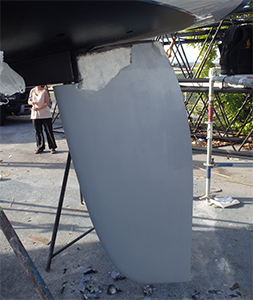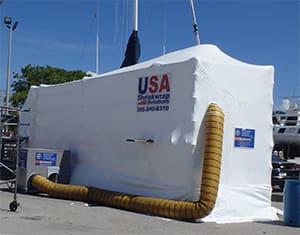To the editor: Living in the heat of south Florida, I never thought my 15-year-old sailboat would have any resins, polyesters or epoxies that would not be fully cured by now. However, as the blistering tropical sun had baked the blue gelcoat of my hull beyond any hope of compounding and wet sanding back to glossy Stars-and-Stripes blue, we had to paint the topsides.
Stringent environmental regulations require that, before painting, a boat must have extensive scaffolding erected around it and a shrink-wrap plastic tent set up to envelop the boat in order to contain any sanding dust and paint overspray. The output from a large air conditioner is piped in to reduce the temperature and humidity for worker comfort and optimum paint performance. The air conditioner is only run when the personnel are present and actively working. At those other times, with temperatures in the mid-80s, the tent functions as a huge oven.
 |
|
A square held up to the rudder shows the extent of the blister. |
|
Ron Schaper |
Several days after the boat was tented, my paint contractor noted two large bulges or blisters on the port side of my rudder. The lower bulge was about the size of a dinner plate and protruded about an inch above the surface. Eighteen inches above this, there was another smaller bulge.
When we pierced the fiberglass shell of the rudder with a 1-inch hole saw, a distinct hiss of pressurized gas escaping was heard. Inside, the foam was perfectly dry and the skin had expanded about three-quarters of an inch above the foam. When the upper bulge was drilled, it too hissed with escaping gas and the hump collapsed like a punctured balloon.
Subsequent conversations with the boat manufacturer and others in the fiberglass industry produced comments like, “Oh, that’s outgassing … it’s not uncommon … it’s caused by resins that have not fully catalyzed finally curing and giving off gases.”
So, when the rudder was made, the rudderstock or shaft, with its “flag” of support structure was put in a mold. A special resin and hardener were mixed and poured into the mold, filling any voids. After it solidified into a dense structural foam — and hopefully fully “cured” — it was removed from the mold and the fiberglass shell was built upon it. The fiberglass essentially sealed the rudder.
 |
|
The rudder with a new section installed. |
|
Ron Schaper |
In its element (underwater), the rudder stays relatively cool, even with our summer water temperatures nearing 90 degrees. During periodic haulouts for bottom painting, the boat is usually out of the water for only a few days and the bottom and rudder are open to ambient air temperatures. However, it seems that a few days in an oven-like tent was enough to awaken 15-year-old residual uncured chemicals in the rudder, which produced enough pressure to bulge 3/8-inch-thick fiberglass.
Then came the “experts.”
“Oh, you need a new rudder,” said one.
“You must remove the rudder and split it open like a clamshell,” said another.
 |
|
The rebuilt rudder, primed and ready for final paint coats. |
|
Ron Schaper |
Conferring with a few experienced fiberglass contractors, plus information from the boat manufacturer, assured me that the correct procedure was to cut out the delaminated glass, then grind and fair the edges, and then apply the manufacturer’s schedule and specification of fiberglass cloth and vinyl ester resin, followed by something called “Peel Ply,” a special release fabric that ensures a smooth surface, reducing final sanding.
The surface was then coated with Interprotect 2000, a barrier coat, followed by a few layers of Micron Extra bottom paint.
How could this all have been avoided?
I am told that a good practice when using fiberglass and foam resins, which must catalyze to fully cure, is to use infrared lamps to heat the parts before sealing them in a shell.
Also, if the rudder had not been subjected to the oven-like temperatures under the plastic tent, there likely would not have been an issue with uncured materials. So the next time you haul your boat, try not to bake it.
—Ron Schaper sails and charters his Sabre 402 out of Ft. Lauderdale, Fla. You can contact him at CaptainRonYachtCharters.com.

